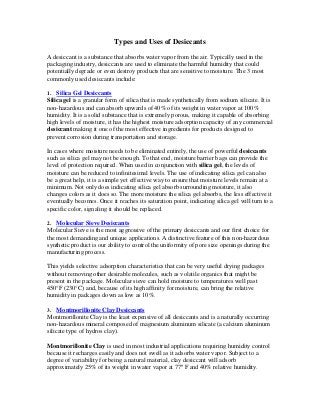
Types and Uses of Desiccants
- 1. Types and Uses of Desiccants A desiccant is a substance that absorbs water vapor from the air. Typically used in the packaging industry, desiccants are used to eliminate the harmful humidity that could potentially degrade or even destroy products that are sensitive to moisture. The 3 most commonly used desiccants include: 1. Silica Gel Desiccants Silica gel is a granular form of silica that is made synthetically from sodium silicate. It is non-hazardous and can absorb upwards of 40% of its weight in water vapor at 100% humidity. It is a solid substance that is extremely porous, making it capable of absorbing high levels of moisture, it has the highest moisture adsorption capacity of any commercial desiccant making it one of the most effective ingredients for products designed to prevent corrosion during transportation and storage. In cases where moisture needs to be eliminated entirely, the use of powerful desiccants such as silica gel may not be enough. To that end, moisture barrier bags can provide the level of protection required. When used in conjunction with silica gel, the levels of moisture can be reduced to infinitesimal levels. The use of indicating silica gel can also be a great help, it is a simple yet effective way to ensure that moisture levels remain at a minimum. Not only does indicating silica gel absorb surrounding moisture, it also changes colors as it does so. The more moisture the silica gel absorbs, the less effective it eventually becomes. Once it reaches its saturation point, indicating silica gel will turn to a specific color, signaling it should be replaced. 2. Molecular Sieve Desiccants Molecular Sieve is the most aggressive of the primary desiccants and our first choice for the most demanding and unique applications. A distinctive feature of this non-hazardous synthetic product is our ability to control the uniformity of pore size openings during the manufacturing process. This yields selective adsorption characteristics that can be very useful drying packages without removing other desirable molecules, such as volatile organics that might be present in the package. Molecular sieve can hold moisture to temperatures well past 450°F (230°C) and, because of its high affinity for moisture, can bring the relative humidity in packages down as low as 10%. 3. Montmorillonite Clay Desiccants Montmorillonite Clay is the least expensive of all desiccants and is a naturally occurring non-hazardous mineral composed of magnesium aluminum silicate (a calcium aluminum silicate type of hydros clay). Montmorillonite Clay is used in most industrial applications requiring humidity control because it recharges easily and does not swell as it adsorbs water vapor. Subject to a degree of variability for being a natural material, clay desiccant will adsorb approximately 25% of its weight in water vapor at 77º F and 40% relative humidity.
- 2. This desiccant works well at low and room temperatures, but has a rather low ceiling temperature. At 120º F montmorillonite clay will begin to desorb or shed the moisture it has adsorbed, an important consideration for storage in hot areas. Desiccants on their own can be extremely effective, although they work better when used in combination with moisture barrier bags. Different moisture barrier bag materials come with different MVTR ratings. These ratings are extremely important, as they are the only reference point when it comes to the amount of moisture that can seep in over a period of time. Currently, the most effective moisture barrier bag material has an MVTR rating of 0.02, meaning that only 0.02 grams of moisture can penetrate the material over a 24-hour period in 95 percent humidity. Proper protection from moisture is important. To that end, combining moisture barrier bags with a desiccant is one of the most efficient ways to protect your goods. No matter how effective a moisture barrier bag may be, there is always a possibility that a minute amount of moisture may seep in. The use of desiccants is a smart preventive measure for added protection. About Protective Packaging Protective Packaging specializes in protecting products, equipment, and machinery from corrosion, electrostatic discharge, contaminants, ultraviolet rays and dust during shipping and storage. Our corrosion prevention products and services consist of: anti-static and static shielding bags, flexible packaging materials, moisture barrier bags, Mil-Spec (military specified) packaging materials, corrosion inhibitors, desiccants, humidity indicator devices, on-site packaging, packaging consulting, and custom-made packaging. For more information, please visit http://www.protectivepackaging.net